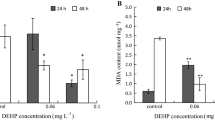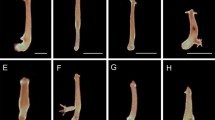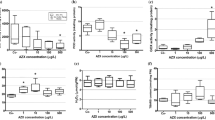Abstract
Triclosan, bisphenol A (BPA) and bisphenol A diglycidyl ether (BADGE) are widely used in cosmetics, cleaners and plastic bowls. However, triclosan has been detected in sewage samples after treatment. Moreover, BPA and BADGE are thought to be endocrine disruptors, and these chemicals bio-accumulate in aquatic living organisms. Human skin and oral tissues are commonly exposed to phenolic chemicals such as triclosan, BPA and BADGE. These types of cells have an excellent regeneration capacity. Hydra magnipapillata inhabits rivers and ponds, and is widely used as a test species because of its ability to rapidly regenerate. Therefore, we investigated the biological toxicity of phenolic chemicals (triclosan, BPA and BADGE) using the freshwater cnidarian, Hydra magnipapillata. We observed severe biological damage after exposure to 1-5 ppm of each of the phenolic chemicals tested. In the Hydra magnipapillata exposed to triclosan (1 ppm, 4 h), there was epidermal tissue and nematocyst damage. Although we did not observe significant biological toxicity in regenerated tissue from Hydra magnipapillata treated with BPA and BADGE, the regeneration capacity was inhibited in the group exposed to triclosan. Hydra tentacles that were treated with phenolic chemicals (1 ppm, 4 h) were moved to a control medium in order to assess recovery after exposure to triclosan, BPA and BADGE. There was no significant difference between the treated and control groups. Moreover, there was no difference in apoptosis, as viewed with a confocal laser microscope, between the endocrine-disrupting phenolic chemicalexposed groups and regeneration groups. The results of this study suggest that BPA and BADGE do not exhibit biological toxicity, but triclosan has toxic effects on the cellular reproduction process that is part of regeneration in Hydra magnipapillata.
Similar content being viewed by others
References
Glaser, A. The ubiquitous Triclosan. A common antibacterial agent exposed. Pesticides and You 24:12–17 (2004).
Lee, I. J., Lee, C. G., Heo, S. N. & Lee, J. W. Determination of personal care products in aquatic environmental samples by GC/MS. Analytical Science & Technology 23:477–484 (2010).
Peng, X. et al. Occurrence of steroid estrogens, endocrine-disrupting phenols, and acid pharmaceutical residues in urban riverine water of the Pearl River Delta, South China. Sci Total Environ 397:158–166 (2008).
Vandenberg, L. N., Hauser, R., Marcus, M., Olea, N. & Welshons, W. V. Human exposure to bisphenol A (BPA). Reprod Toxicol 24:139–177 (2007).
Maffini, M. V., Rubin, B. S., Sonnenschein, C. & Soto, A. M. Endocrine disruptors and reproductive health: The case of bisphenol-A. Mol Cell Endocrinol 254–255:179–186 (2006).
Jesús, S., Ramón, B. & Cristina, N. Use of solid-phase microextraction for the analysis of bisphenol A and bisphenol A diglycidyl ether in food simulants. J Chromatogr 864:137–144 (1999).
KFDA, Korea Food & Drug Administration. toxic information of phenol (2010): Available online at http://toxinfo.nifds.go.kr/SearchUtil_getDetailChemTcd.action?hddnToxicCode=T1000000338.
Wilby, O. K. “The Hydra regeneration assay,” in Proceedings of Workshop Organised by Association Francaise de Teratologie. 108–124 (1988).
Schuchert, P. Hydrozoa Directory (2005): Available online at http://www.ville-ge.ch/mhng/hydrozoa/intro/nematocysts.htm.
Tositaka, F. Hydra regeneration and epitheliopeptides. Dev Dyn 226:182–189 (2003).
Ulrike, E. et al. Nowa, a novel protein with minicollagen Cys-rich domains, is involved in nematocyst formation in Hydra. J Cell Sci 115:3923–3934 (2002).
Fujisawa, T. & David, C. N. Commitment during stenotele differentiation in hydra is localized near the S/G2 boundary in the terminal cell cycle. Dev Biol 93:226–230 (1982).
Böttger, A. & Alexandrova, O. Programmed cell death in Hydra. Semin Cancer Biol 17:134–146 (2007).
Safe, S. H. et al. Toxicology of environmental estrogens. Repord Fertil Dev 13:307–315 (2001).
Bond, G. P. et al. Reproductive effects of bisphenol A, 19th Annual Meeting of the Society of Toxicology, Washington D.C. 294 (1980).
Steinmetz, R., Brown, N. G., Allen, D. L., Bigsby, R. M. & Benjonathan, N. The environmental estrogen bisphenol A stimulates prolactin release in vitro and in vivo. Endocrinology 138:1780–1786 (1997).
Hanaoka, T., Kawamura, N., Hara, K. & Tsugane, S. Urinary bisphenol A and plasma hormone concentrations in male workers exposed to bisphenol A diglycidyl ether and mixed organic solvents. Occup Environ Med 59:625–628 (2002).
Yeo, M. K. Effects of bisphenol A and nonylphenol on zebrafish embryogenesis. Kor J Env Hlth 29:1–9 (2003).
Kim, S. J. et al. Genomic alteration of bisphenol A treatment in the testis of mice. Mol Cell Toxicol 5:216–221 (2009).
Miller, D. J. et al. The innate immune repertoire in Cnidaria-ancestral complexity and stochastic gene loss. Genome Biol 8:1–13 (2007).
Trottier, S., Blaise, C., Kusui, T. & Johnson, E. M. Acute toxicity assessment of aqueous samples using a microplate-based hydra attenuata assay. Environ Toxicol Water Qual 12:265–271 (1997).
Pachura-Bouchet, S., Blaise, C. & Vasseur, P. Toxiciy of nonylphenol on the cnidarian hydra attenuata and environmental risk assessment. Environ Toxicol 21:388–394 (2006).
Karntanut, W. & Pascoe, D. The toxicity of copper, cadmium and zinc to four different Hydra (Cnidaria: Hydrozoa). Chemosphere 47:1059–1064 (2002).
Yeo, M. K. & Kang, M. S. The effect of nano-scale Zn-doped TiO2 and pure TiO2 particles on Hydra magnipapillata. Mol Cell Toxicol 6:9–17 (2010).
Author information
Authors and Affiliations
Corresponding author
Rights and permissions
About this article
Cite this article
Park, HG., Yeo, MK. The toxicity of triclosan, bisphenol A, bisphenol A diglycidyl ether to the regeneration of cnidarian, Hydra magnipapillata . Mol. Cell. Toxicol. 8, 209–216 (2012). https://doi.org/10.1007/s13273-012-0026-4
Received:
Accepted:
Published:
Issue Date:
DOI: https://doi.org/10.1007/s13273-012-0026-4




